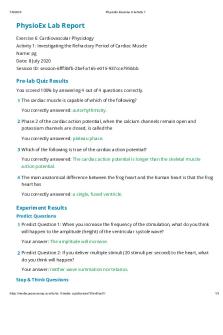Physio Ex Exercise 6 Activity 1 PDF

| Title | Physio Ex Exercise 6 Activity 1 |
|---|---|
| Author | Kyleigh Hankton |
| Course | Human Anatomy Laboratory |
| Institution | Alcorn State University |
| Pages | 3 |
| File Size | 127.6 KB |
| File Type | |
| Total Downloads | 72 |
| Total Views | 152 |
Summary
The work for this class...
Description
2/13/2021
PhysioEx Exercise 6 Activity 1
PhysioEx Lab Report Exercise 6: Cardiovascular Physiology Activity 1: Investigating the Refractory Period of Cardiac Muscle Name: Kyleigh Hankton Date: 13 February 2021 Session ID: session-24359116-7d0b-2a6a-56a4-0d72dd771770
Pre-lab Quiz Results You scored 100% by answering 4 out of 4 questions correctly. 1 The cardiac muscle is capable of which of the following? You correctly answered: autorhythmicity. 2 Phase 2 of the cardiac action potential, when the calcium channels remain open and potassium channels are closed, is called the You correctly answered: plateau phase. 3 Which of the following is true of the cardiac action potential? You correctly answered: The cardiac action potential is longer than the skeletal muscle action potential. 4 The main anatomical difference between the frog heart and the human heart is that the frog heart has You correctly answered: a single, fused ventricle.
Experiment Results Predict Questions 1 Predict Question 1: When you increase the frequency of the stimulation, what do you think will happen to the amplitude (height) of the ventricular systole wave? Your answer: The amplitude will not change. 2 Predict Question 2: If you deliver multiple stimuli (20 stimuli per second) to the heart, what do you think will happen? Your answer: neither wave summation nor tetanus. Stop & Think Questions https://media.pearsoncmg.com/bc/bc_0media_ap/physioex/10/ex6/act1/
i 1/3
2/13/2021
PhysioEx Exercise 6 Activity 1
1 Watch the contractile activity from the frog heart on the oscilloscope. Enter the number of ventricular contractions per minute (from the heart rate display). You answered: 60 beats/min. 2 Which of the following statements about the contractile activity is true? You correctly answered: The smaller waves represent the contraction of the atria. 3 During which portion of the cardiac muscle contraction is it possible to induce an extrasystole? You correctly answered: during relaxation. Experiment Data
Post-lab Quiz Results You scored 100% by answering 4 out of 4 questions correctly. 1 The amplitude of the ventricular systole did not change with the more frequent stimulation because You correctly answered: a new contraction could not begin until the relaxation phase. i https://media.pearsoncmg.com/bc/bc_0media_ap/physioex/10/ex6/act1/
2/3
2/13/2021
PhysioEx Exercise 6 Activity 1
2 Which of the following do you think contribute to the inability of cardiac muscle to be tetanized? You correctly answered: the long refractory period of the cardiac action potential. 3 Given the function of the heart, why is it important that cardiac muscle cannot reach tetanus? You correctly answered: The ventricles must contract and relax fully with each beat to pump blood. 4 An extrasystole corresponds to You correctly answered: an extra ventricular contraction.
Review Sheet Results 1 Explain why the larger waves seen on the oscilloscope represent the ventricular contraction. Your answer: Ventricle contraction is stronger than atrial contraction. 2 Explain why the amplitude of the wave did not change when you increased the frequency of the stimulation. (Hint: relate your response to the refractory period of the cardiac action potential.) How well did the results compare with your prediction? Your answer: Amplitude did not change because of the cardiac long refractory period, as predicted. 3 Why is it only possible to induce an extrasystole during relaxation? Your answer: The extrasystole can not occur until relaxation and so we could not achieve wave summation tetanus. 4 Explain why wave summation and tetanus are not possible in cardiac muscle tissue. How well did the results compare with your prediction? Your answer: Cardiac cells have longer twitches than any other muscle cells. As I correctly predicted, the cardiac muscle tissue showed neither wave summation nor tetanus.
i https://media.pearsoncmg.com/bc/bc_0media_ap/physioex/10/ex6/act1/
3/3...
Similar Free PDFs

Physio Ex Exercise 6 Activity 1
- 3 Pages

Physio Ex Exercise 6 Activity 1
- 3 Pages

Physio Ex Exercise 6 Activity 1
- 3 Pages

Physio Ex Exercise 6 Activity 1
- 5 Pages

Physio Ex Exercise 6 Activity 1
- 5 Pages

Physio Ex Exercise 6 Activity 4
- 5 Pages

Physio Ex Exercise 5 Activity 6
- 3 Pages

Physio Ex Exercise 6 Activity 4
- 5 Pages

Physio Ex Exercise 6 Activity 3
- 3 Pages

Physio Ex Exercise 6 Activity 3
- 3 Pages

Physio Ex Exercise 2 Activity 6
- 6 Pages

Physio Ex Exercise 6 Activity 5
- 4 Pages

Physio Ex Exercise 6 Activity 4
- 5 Pages

Physio Ex Exercise 5 Activity 6
- 3 Pages

Physio Ex Exercise 5 Activity 6
- 3 Pages

Physio Ex Exercise 3 Activity 6
- 5 Pages
Popular Institutions
- Tinajero National High School - Annex
- Politeknik Caltex Riau
- Yokohama City University
- SGT University
- University of Al-Qadisiyah
- Divine Word College of Vigan
- Techniek College Rotterdam
- Universidade de Santiago
- Universiti Teknologi MARA Cawangan Johor Kampus Pasir Gudang
- Poltekkes Kemenkes Yogyakarta
- Baguio City National High School
- Colegio san marcos
- preparatoria uno
- Centro de Bachillerato Tecnológico Industrial y de Servicios No. 107
- Dalian Maritime University
- Quang Trung Secondary School
- Colegio Tecnológico en Informática
- Corporación Regional de Educación Superior
- Grupo CEDVA
- Dar Al Uloom University
- Centro de Estudios Preuniversitarios de la Universidad Nacional de Ingeniería
- 上智大学
- Aakash International School, Nuna Majara
- San Felipe Neri Catholic School
- Kang Chiao International School - New Taipei City
- Misamis Occidental National High School
- Institución Educativa Escuela Normal Juan Ladrilleros
- Kolehiyo ng Pantukan
- Batanes State College
- Instituto Continental
- Sekolah Menengah Kejuruan Kesehatan Kaltara (Tarakan)
- Colegio de La Inmaculada Concepcion - Cebu